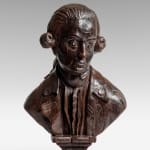Late 18th Century Carved Oak Bust of Major John André
20 ¼ x 12 ¼ x 8 ½ in
Further images
Modelled looking slightly downwards and to sinister, his hair tied back with curl at each temple. Wearing a shirt and a cravat beneath a coat with a buttoned collar and lapels. The lower section of the socle restored.
Major John André (1750 – 1780): John André was, for a brief period at the end of the 18th and the beginning of the 19th Centuries, and on both sides of the Atlantic, one of the most celebrated figures of the day. Hanged as a spy in 1780 by American forces during the War of Independence, he was mourned by George Washington just days after his death as 'an accomplished man and gallant officer' (in a letter to Colonel John Laurens, 13th October 1780) and 'more unfortunate than criminal' (in a letter to Comte de Rochambeau, 10th October 1780).
André was the son of Anthony and Marie-Louise André (daughter of Paul Girardot of Paris). On 25th January 1771 he purchased a commission in the British Army and, shortly afterwards, he was posted to America. In 1779, he was promoted to Adjutant General, with the rank of Major, to General Sir Henry Clinton, Commander of the British Army in New York.
André charmed colonial society with his skills as an artist, poet, singer and linguist, and he was a much admired figure in both Philadelphia (where he lived with the family of Benjamin Franklin) and later in New York. Serving as his regiment's social director in the winter of 1778, he was behind ‘The Mischianza’, a weeklong tribute to honour the retiring British General William Howe, and one of the most legendary in American history. At a cost of 3,312 guineas, events included: a regatta along the Delaware River accompanied by three musical bands and a seventeen-gun salute by British warships; a tournament of jousting knights; a ball; and a banquet with a fireworks display.
André became aide to the newly arrived General Sir Henry Clinton, Howe's replacement, and in 1779 was put in charge of the British Secret Intelligence network. On 10th May, he received word that American Major General Benedict Arnold, then military commander of Philadelphia, wished to defect. Arnold, commander of West Point, a key American fortress on the Hudson River, offered to surrender the fort's plans in exchange for £20,000 and a commission in the British Army equal to his current American rank.
Following negotiations at the end of September, André was captured behind enemy lines. He was in disguise, without his uniform, and had the incriminating West Point plans concealed in his boot. He was sentenced to death and, despite pleading with George Washington to die honorably via a firing squad, he was hanged – the traditional execution method for a spy – at Tappan, New York on 2nd October 1780 and then buried beneath the gallows. At his execution, André’s popularity was demonstrated, as many of the Americans who had gathered to watch cried.
He became a romantic hero in England and, almost immediately after his death, ballads were written about him, and his image was circulated in a number of engravings and prints. A memorial was erected on the site of his execution in Tappan by James Lee, a merchant of New York, but was replaced in 1879 by Cyrus Field. After the war, in 1782, a monument was erected in Westminster Abbey at the expense of King George III and it was proposed that his bones should be brought back for burial. In 1821, at the Duke of York's request, André’s remains were returned to England and were buried at Westminster Abbey, in front of the monument to him. This monument was designed by Robert Adam and sculpted by Peter Mathias Van Gelder. The wooden chest – the Sarcophagus that brought his bones to England – has been preserved and is housed in the Abbey's triforium. The monument shows a mourning figure of Britannia with a lion, seated on top of a sarcophagus. On the front is a relief showing George Washington in a tent receiving a petition, and Major André being led away to execution. The inscription reads: ‘SACRED to the MEMORY of MAJOR JOHN ANDRÉ, who raised by his Merit at an early period of Life to the rank of Adjutant General of the British Forces in America, and employed in an important but hazardous Enterprise fell a Sacrifice to his Zeal for his King and Country on the 2nd of October AD 1780 Aged 29, universally Beloved and esteemed by the Army in which he served and lamented even by his FOES. His gracious Sovereign KING GEORGE the Third has caused this Monument to be erected. The Remains of Major JOHN ANDRÉ Were, on the 10th of August 1821, removed from Tappan, By JAMES BUCHANAN ESQr His Majesty's Consul at New York, Under instructions from His Royal Highness The DUKE of YORK, And, with the permission of the Dean and Chapter, Finally deposited in a Grave Contiguous to this Monument, On the 28th of November 1821.’
Thomas Sully’s painting, The Capture of Major André, depicts the events when Major John André was captured near Tarrytown on 23rd September 1780. The three Americans – the militiamen who captured him – were from New York: John Paulding; Isaac Van Wart; and David Williams. Sully shows the militiamen having found the West Point-related documents in André’s boot.








